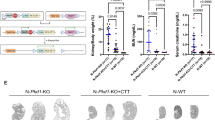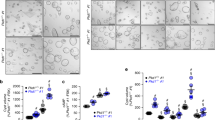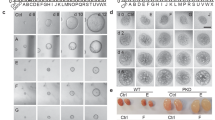Abstract
POLYCYSTIC kidney diseases (PKD) are the most common hereditary diseases of the human kidney and account for ten per cent of patients requiring renal transplantation or dialysis. Renal cyst formation has been attributed to enhanced cell proliferation, unbalanced cell death, abnormal targeting of membrane proteins, aberrant kidney development and tubular obstruction, but there is no treatment that blocks the formation and enlargement of renal cysts. We have now developed an in vitro model of spontaneous cyst formation that distinguishes polycystic kidney epithelium from its normal counterpart. Inhibitors of DNA, RNA and protein synthesis did not prevent in vitro cyst formation, but this was reversibly inhibited by ouabain, amiloride and the microtubule-specific agents colchicine, vinblastine and taxol. The cpk mouse is a well-characterized recessive PKD model1–3 and we find that cpk/cpk mice develop PKD and die from uraemia by 4–5 weeks of age, but when treated weekly with taxol they survive for more than 200 days with minimal loss of renal function, show limited collecting-dust cyst enlargement, and attain adult size. Our results indicate that the microtubule cytoskeleton has a central role in the pathogenesis of PKD in cpk mice and that taxol may also be useful in treating human PKD.
This is a preview of subscription content, access via your institution
Access options
Subscribe to this journal
Receive 51 print issues and online access
$199.00 per year
only $3.90 per issue
Buy this article
- Purchase on Springer Link
- Instant access to full article PDF
Prices may be subject to local taxes which are calculated during checkout
Similar content being viewed by others
References
Russell, E. S. & McFarland, E. Mouse Newsletter 56, 40 (1977).
Preminger, G. M., Koch, W. E., Fried, F. A., McFarland, E. & Murphy, E. M. J. J. Urol. 127, 556–560 (1982).
Avner, E. D. et al. Pediat. Nephrol. 1, 587–596 (1987).
Wilson, P. D., Schrier, R. W., Breckon, R. D. & Gabow, P. A. Kidney Int. 30, 371–378 (1986).
Yang, A. H., Gould, K. J. & Oberley, T. D. In Vitro Cell Dev. Biol. 23, 34–46 (1987).
Carone, F. A., Nakamura, S., Schumacher, B. S., Punyarit, P. & Bauer, K. D. Kidney Int. 35, 1351–1357 (1989).
Valentich, J. D., Tchao, R. & Leighton, J. J. Cell Physiol. 100, 291–304 (1979).
Mangoo, K. R. et al. FASEB J. 3, 2629–2632 (1989).
Neufeld, T. K. et al. 41, 1222–1236 (1992).
Fleming, T. P. & Johnson, M. H. A. Rev. cell. Biol. 4, 459–485 (1988).
Brenner, B. M. Kidney Int. 23, 647–655 (1983).
Schiff, P. & Horwitz, S. Proc. natn. Acad. Sci. U.S.A. 77, 1561–1565 (1980).
Gattone, V. H. et al. Lab. Invest. 59, 231–238 (1988).
Cowley, B. D. J., Smardo, F. L. J., Grantham, J. J. & Calvert, J. P. Proc. natn. Acad. Sci. U.S.A. 84, 8394–8398 (1987).
Avner, E. D., Sweeney, W. E. J., Young, M. C. & Ellis, D. Pediat. Nephrol. 2, 210–218 (1988).
Cowley, B., Chadwick, L., Grantham, J. & Calvert, J. J. Am. Soc. Neph. 1, 1048–1053 (1991).
Kelly, R. Cell 60, 5–7 (1990).
Rogalski, A. A., Bergmann, J. E. & Singer, S. J. J. Cell Biol. 99, 1101–1109 (1984).
Thyberg, J. & Moskalewski, S. Expl Cell Res. 159, 1–16 (1985).
Lippincott-Schwartz, J. et al. Cell 60, 821–836 (1990).
Bloom, T. Development 106, 159–171 (1989).
Maro, R., Gueth-Hallonet, C. J. A. & Antony, C. Development Vol. 1, suppl. 1, 17–25 (1991).
Parczyk, K., Haase, W. & Kondor-Koch, C. J. biol. Chem. 264, 16837–16846 (1989).
De Almeida, J. B. & Stow, J. L. Am. J. Physiol. 260, C691–C700 (1991).
Wilson, P. D. et al. Am. J. Physiol. 260, F420–F430 (1991).
Avner, E., Sweeney, W. & Nelson, W. Proc. natn. Acad. Sci. U.S.A. 89, 7447–7451 (1992).
Slot, C. Scand. J. Clin. Lab. Invest. 17, 381–387 (1965).
Author information
Authors and Affiliations
Rights and permissions
About this article
Cite this article
Woo, D., Miao, S., Pelayo, J. et al. Taxol inhibits progression of congenital polycystic kidney disease. Nature 368, 750–753 (1994). https://doi.org/10.1038/368750a0
Received:
Accepted:
Issue Date:
DOI: https://doi.org/10.1038/368750a0
This article is cited by
-
Prioritized polycystic kidney disease drug targets and repurposing candidates from pre-cystic and cystic mouse Pkd2 model gene expression reversion
Molecular Medicine (2023)
-
1-Indanone retards cyst development in ADPKD mouse model by stabilizing tubulin and down-regulating anterograde transport of cilia
Acta Pharmacologica Sinica (2023)
-
A high-throughput screening platform for Polycystic Kidney Disease (PKD) drug repurposing utilizing murine and human ADPKD cells
Scientific Reports (2020)
-
Semi-continuous production of the anticancer drug taxol by Aspergillus fumigatus and Alternaria tenuissima immobilized in calcium alginate beads
Bioprocess and Biosystems Engineering (2020)
-
Strain improvement and immobilization technique for enhanced production of the anticancer drug paclitaxel by Aspergillus fumigatus and Alternaria tenuissima
Applied Microbiology and Biotechnology (2019)
Comments
By submitting a comment you agree to abide by our Terms and Community Guidelines. If you find something abusive or that does not comply with our terms or guidelines please flag it as inappropriate.



